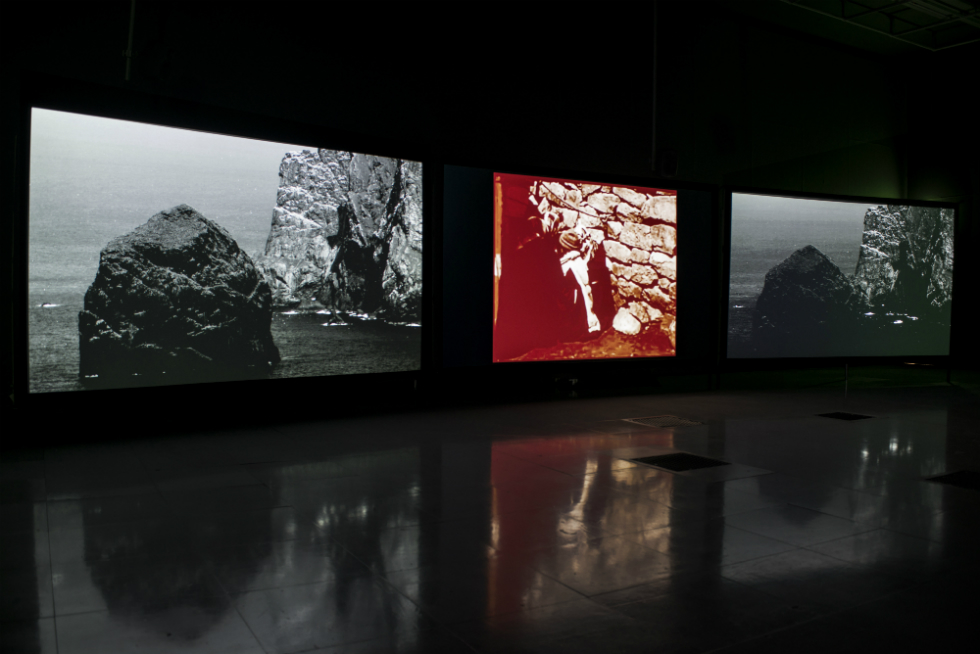Haunting Isolation And Lost Memories: Lesions In The Landscape — Reviewed

Ellie Woods sees an abandoned Scottish town through the eyes of an amnesiac at FACT’s current, discordant exhibition…
Shona Illingworth wants us to experience the edge of the world. At least that’s what it feels like. Edging down a dark passageway in Lesions In The Landscape at FACT (Liverpool) – past a sign stating that the door is to be kept closed to preserve the immersive experience that awaits within – we are confronted with three large screens. All around the room, the shapes of countless speakers can almost be made out in the dim glow of the emergency exit signs. At first it is silent, but then a sudden note is sung out as an imposing column of rock appears on film. A Gaelic hymn surges as the camera moves along with the motion of the sea waves. Gannets call loudly overhead.
This is St Kilda, as seen through the eyes of Illingworth: a collection of tiny islands in the Scottish hebrides which make up the most remote part of the British Isles. Evacuated in 1930, it now exists as a World Heritage Site and is also one of the most important nature reserves for sea birds in Europe. Present day St Kilda is also seen through the eyes of Claire, an amnesiac who has lost all of her past memories, along with her ability to create long-term memories anew.
The eerie voices of the hymn singers fade and Claire’s voice emerges, her image fading in and out of the centre screen. The birds still flit around but their images are now in negative, and we get a sense of the familiar becoming obscured. As Claire describes her experience of losing her entire past, the links between herself and the depilated archipelago of St Kilda become clear. If our experiences make us who we are, then the inability to remember these has left Claire grasping at ephemeral memories, relying solely on the knowledge of others in order to reconstruct her life.
Similarly, St Kilda was abandoned 85 years ago: the homes visible on screen now stand in ruin. We rely on outsiders to surmise its stories and it is Illingworth who takes on this role. Born in Denmark but raised in the Scottish Highlands, her Gaelic lilt is in harmony with these desolate and otherworldly scenes. Archival footage of the evacuation is presented as she describes the story behind the desertion of the islands. Everything is disjointed, the jolting footage lagging between each screen. It proves difficult to focus on the images along with Illingworth’s narrative, under which disconcerting ambient and synthesized sound effects can constantly be heard.

A lot of effort is required in order to follow exactly what is happening as Lesions In The Landscape jumps between Illingworth, Claire, and also Martin A. Conway: a neuropsychologist who attempts to explain some of the science behind Claire’s condition. The camera swings violently around, surely imitating the ‘sensecam’ which we later learn Claire wears around her neck. This device takes intermittent photos which can then be pieced together later in order to form something which would resemble a memory path, triggering recollections. The whole discordant nature of the installation seems entirely purposeful and allows the viewer some insight into life with amnesia.
This work is very typical of Illingworth, who has a history of exploring memory from a psychological perspective through sound and video installation. It is understandable why she would be intrigued by such a subject when the ruminations of Conway only act to inform us on just how little we understand of how the human brain functions. The idea of identity is also a common motif in Illingworth’s work, and this is really brought out by the inclusion of St Kilda’s mysterious past. A past where most of the focus is placed on its dramatic evacuation, as Illingworth powerfully states: “Its history is dominated by its last gasp.” This parallels with Claire, who may never recall anything before the onset of her amnesia.
As the speakers die out and the video fades back to black, we return to the busy environment of FACT’s foyer. This almost comes as a shock to the system after sitting in dark isolation, so consumed by the melancholic images and harmonies of Illingworth’s creation. Upstairs, in Gallery Two, the Amnesia Museum has been curated as an archive of the installation and a deeper exploration of amnesia itself. Upon entering, the eyes are immediately drawn to a central podium on which two mysterious shapes sit, their white surfaces contrasting sharply against the background of the, again, dark room. These are labelled as two differently ratioed models of the lesions which grew in Claire’s brain, causing her right temporal lobe to be permanently damaged. Illingworth’s context for the title becomes clear: with their cliff-like surface, the lesions closely resemble the jutting presence of St Kilda’s sea stacks.
The continuation of the artistic process is closely documented throughout the exhibition, with stills from various camera angles, maps created from GPS tracking of those involved in the process, and more archival images whose contents are described by Illingworth on a looping track. And this is not the only sound in the room. In the bottom left corner hangs a web of speaker-like devices, letting out a series of dissonant notes. Standing in the centre of these, one immediately recollects this as the unearthly sound repeated throughout the downstairs installation. A placard explains that these were the signals given off by an electroencephalogram, which Claire wore as she explored the islands. It almost feels uncomfortable to in some way be experiencing the memories which she failed to retain.
This unnerving feeling stays with you as you leave Lesions in the Landscape, away from the cacophony of noise yet still suffering from the ringing ears. The installation is a haunting one, with memories of it pervading long into its aftermath, an imprint of the gigantic sea stack looming over every thought. It is emotionally draining to conceive of a future for the lonely islands of St Kilda and for Claire, the personification of its tragedy. But there is no doubt to the power of Illingworth’s creation. The Gaelic hymns, like a spell, call you down into the dark to sit, isolated, and look out to sea as if you were right there on the islands. Right on the edge of the world.
Ellie Woods
This article has been commissioned for the collaborative #BeACritic project — an annual programme of mentoring and commissioned critical articles for North-West-based writers, initiated and supported by The Double Negative, Liverpool John Moores University and Arts Council England. See more here
See Lesions In The Landscape at FACT, Liverpool, until 22 November 2015 — FREE





